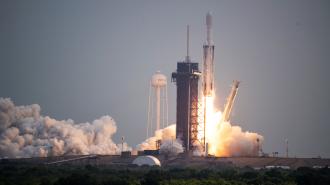NASA has successfully launched its Psyche mission, sending a spacecraft on a 2.5-billion-mile journey to a metal-rich asteroid unlike any we’ve ever studied up close before.
We have liftoff: After poor weather conditions forced NASA to delay the launch by a day, a SpaceX Falcon Heavy rocket carrying the Psyche mission successfully lifted off at Kennedy Space Center at 10:19 a.m. ET on October 13.
The upper and lower rocket stages separated a few minutes later, and SpaceX successfully recovered the side boosters with another impressive upright landing 8 minutes after liftoff.
The Psyche spacecraft separated from the rocket’s upper stage just over an hour after launch. A few minutes later, NASA confirmed that it is in communication with the spacecraft, which is expected to reach the asteroid 16 Psyche in 2029.
Why Psyche? When Italian astronomer Annibale de Gasparis first spotted the Psyche asteroid in 1852, it was the 16th minor planet to be discovered (hence its official name: 16 Psyche).
Since then, astronomers have discovered about a million other asteroids, but most are made of rock and ice. Psyche is the largest metal-rich asteroid we’ve seen, which suggests it could be the partial core of a “planetesimal,” a building block of a planet.
“Humans can’t bore a path to our planet’s core — or the cores of the other rocky planets — so visiting Psyche could provide a one-of-a-kind window into the violent history of collisions and accumulation of matter that created planets like our own,” writes NASA.
“I am excited to see the treasure trove of science Psyche will unlock as NASA’s first mission to a metal world.”
Nicola Fox
Looking ahead: Even though 16 Psyche’s orbit brings it as close as 142 million miles from Earth, the Psyche mission is going to take an energy-saving 2.5-billion-mile path to reach the asteroid in 2029.
Once it arrives at its destination, Psyche will spend 26 months orbiting the metal-rich asteroid, using its array of instruments to collect data that could help astronomers determine whether it is the partial core of a planetesimal or perhaps something else.
“I am excited to see the treasure trove of science Psyche will unlock as NASA’s first mission to a metal world,” said Nicola Fox, associate administrator for NASA’s Science Mission Directorate.
“By studying asteroid Psyche, we hope to better understand our universe and our place in it, especially regarding the mysterious and impossible-to-reach metal core of our own home planet, Earth,” she continued.
We’d love to hear from you! If you have a comment about this article or if you have a tip for a future Freethink story, please email us at [email protected].




